Comfort and style

A stylish art-deco Youth Center building on the road to Angkor
Cambodia - Temples, Books, Films and ruminations...

A stylish art-deco Youth Center building on the road to Angkor
 The new 1-day Angkor pass with photo - please excuse the mug-shot!
The new 1-day Angkor pass with photo - please excuse the mug-shot!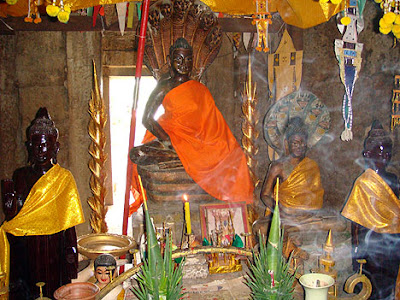 This is the main shrine of the temple of Prasat Premea Cheung Prey, that sits atop Phnom Thom, dedicated to Preah Meada and Preah Ang Pheap. Smoke from incense sticks fills the air.
This is the main shrine of the temple of Prasat Premea Cheung Prey, that sits atop Phnom Thom, dedicated to Preah Meada and Preah Ang Pheap. Smoke from incense sticks fills the air.
Another shrine located in an adjoining building

This reclining Buddha is flanked by two nagas, a small stone lion and several severed heads

Another colourful shrine on top of Phnom Thom with a stone bed

A small open-air shrine at the foot of the hill, contained within a separate laterite prasat
 An Indian-inspired Neak Ta at Phnom Thom in Cheung Prey
An Indian-inspired Neak Ta at Phnom Thom in Cheung Prey A more classical Buddhist pose for this Neak Ta at the foot of the hill
A more classical Buddhist pose for this Neak Ta at the foot of the hill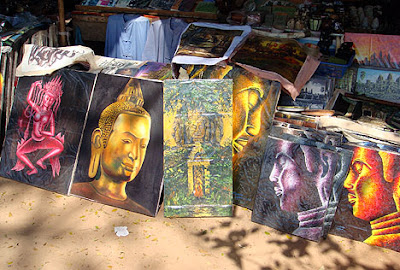
Some examples of his work and other artists on his stall at Angkor Wat

More paintings on sale at Pisey's stall, from $25 and upwards

Fresh-faced Pisey holds up an example of his art at his Angkor Wat stall
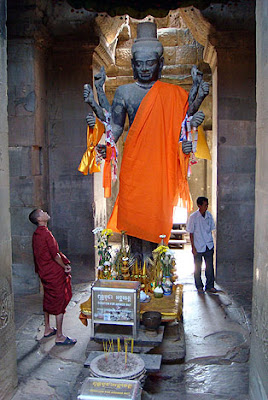
A monk inspects the 8-armed Vishnu at the entrance gopura to Angkor Wat. The original head of this statue was re-attached in 2004.

Talking of heads, the giant's head was detached by an arrow on this painting on the wall of the pagoda's vihara next to the Angkor Wat causeway

Respected historian Ang Choulean at the Hanuman Annual Party, introducing his latest work, Khmer Renaissance

The unusual laterite hilltop temple at Prasat Premea Cheung Prey, a few kilometres from Skun
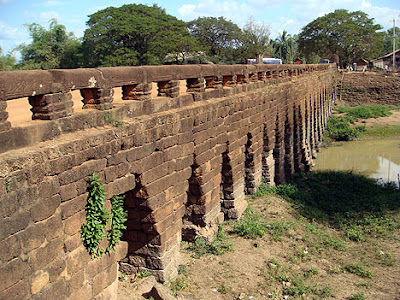 A view of Spean Praptos from the west
A view of Spean Praptos from the west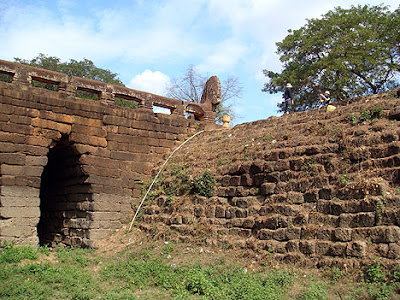 The east section of the bridge showing the corbel arch and the embankment faced with laterite blocks to deter slippage
The east section of the bridge showing the corbel arch and the embankment faced with laterite blocks to deter slippage
The north-west Naga on Spean Praptos with multi-heads. There are 4 Naga heads like this.

A guardian figure on a boundary stone that marks the walkway at the side of the road that spans the bridge

A gormless tourist who got in the way of my photo - oh so predictable!
 A window into the gallery of 1,000 Buddhas
A window into the gallery of 1,000 Buddhas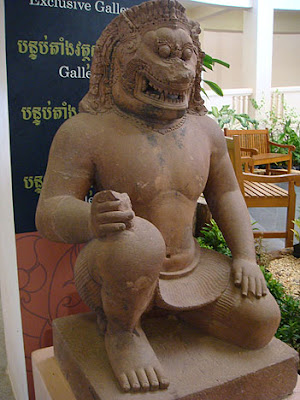 A lion-headed kneeling Asura demon guardian from the 10th century Banteay Srei temple
A lion-headed kneeling Asura demon guardian from the 10th century Banteay Srei temple  This eight-faced head of Brahma was found at Tvear Khmoach, near the west gate of Angkor Thom. It's from the 12th century.
This eight-faced head of Brahma was found at Tvear Khmoach, near the west gate of Angkor Thom. It's from the 12th century. A lion from the 12th century temple of Banteay Kdei
A lion from the 12th century temple of Banteay Kdei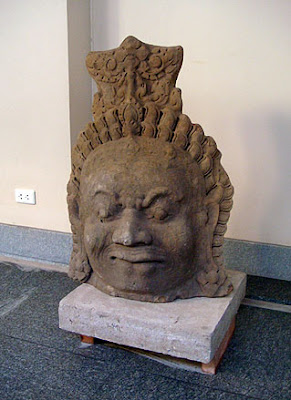 One of the demons, with a typical grimace and headdress, from one of the entrance gates to Angkor Thom. Hundreds of these original sandstone heads are in storage at Angkor Conservation.
One of the demons, with a typical grimace and headdress, from one of the entrance gates to Angkor Thom. Hundreds of these original sandstone heads are in storage at Angkor Conservation.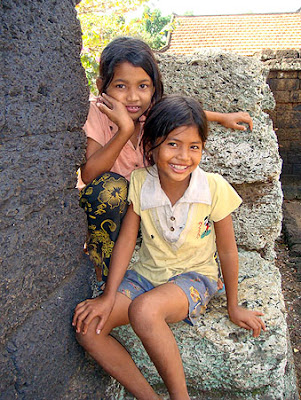 Two of the welcoming committee at Kohak Nokor - the numbers of kids grew steadily during our visit
Two of the welcoming committee at Kohak Nokor - the numbers of kids grew steadily during our visit This was part of the crowd of children that saw us off at Kohak Nokor
This was part of the crowd of children that saw us off at Kohak Nokor Detail from the giant Nagas at Spean Praptos. Considering their age, the bridge and its Nagas are in fantastic condition
Detail from the giant Nagas at Spean Praptos. Considering their age, the bridge and its Nagas are in fantastic condition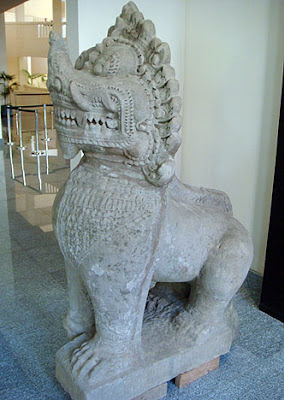 One of the lions from Preah Khan of Kompong Svay, on show at the new Angkor National Museum
One of the lions from Preah Khan of Kompong Svay, on show at the new Angkor National Museum We called into the 11th century temple of Kohak Nokor, as many of our Hanuman team had not visited it before
We called into the 11th century temple of Kohak Nokor, as many of our Hanuman team had not visited it before At our food stop in Kompong Thom, I popped to see Sokhom's daughter, Kunthea (right) and her friend Pisey. Sokhom was with a tourist at Sambor Prei Kuk.
At our food stop in Kompong Thom, I popped to see Sokhom's daughter, Kunthea (right) and her friend Pisey. Sokhom was with a tourist at Sambor Prei Kuk. Another stop en route was at Spean Praptos, the best example of an Angkorean bridge in Cambodia at Kompong Kdei. The main road has been diverted away from the bridge to protect it.
Another stop en route was at Spean Praptos, the best example of an Angkorean bridge in Cambodia at Kompong Kdei. The main road has been diverted away from the bridge to protect it.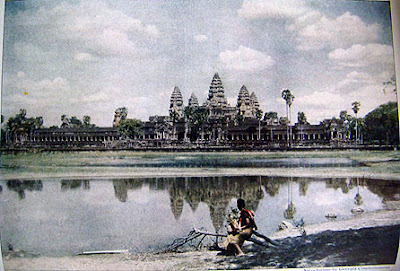 Angkor Wat in 1928
Angkor Wat in 1928 The Angkor complex from the Nat Geo of 1982
The Angkor complex from the Nat Geo of 1982

Stairway leading to the central tower of Angkor Wat (Dieulefils)
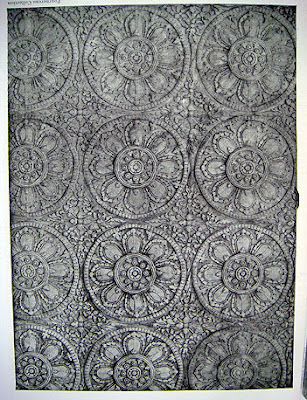
One of the few pieces of the ornately carved wooden ceiling from a gallery at Angkor Wat (Fournereau)

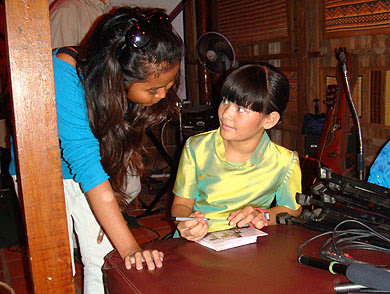
Bosba takes time out to sign copies of her CD
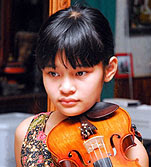 Try and visit the Meta House on Street 264 in Phnom Penh this Wednesday to catch up with a future Khmer star in the form of 10-year-old Bosba Panh (right), who will be performing 'unplugged' on the night from 7pm. A coloratura soprano, she's mature well beyond her age, sings in several languages, plays guitar and leads her own group, La Compagnie BosbaPanh. She comes from a talented family - she's the niece of the famous film director Rithy Panh - and has travelled widely, including a visit to Everest base camp! Already a regular face on Khmer television, she released her first cd - Phnom Penh - last year, an album of songs that recall the happier times of the 1960s including compositions from Norodom Sihanouk, and followed that up with a second release, SrorMay, last month. Her group are all teachers or students from the Royal University of Fine Arts, who play traditional songs in a contemporary style. Bosba was born in Thailand to a Laotian mother and a Cambodian father, Meng Heng Panh, who studied in France and worked as a journalist there during the Khmer Rouge period. You can listen to Bosba on her own website here. Amidst new exhibitions at Meta that seem to be happening every five minutes, the film evenings will continue this coming Saturday when the founder of Cambodian Livings Arts, Arn Chorn-Pond will be present to show the film The Flute Player by Jocelyn Glatzer, whilst The Killing Fields gets a run out on Sunday night. Link: Meta; Flute Player.
Try and visit the Meta House on Street 264 in Phnom Penh this Wednesday to catch up with a future Khmer star in the form of 10-year-old Bosba Panh (right), who will be performing 'unplugged' on the night from 7pm. A coloratura soprano, she's mature well beyond her age, sings in several languages, plays guitar and leads her own group, La Compagnie BosbaPanh. She comes from a talented family - she's the niece of the famous film director Rithy Panh - and has travelled widely, including a visit to Everest base camp! Already a regular face on Khmer television, she released her first cd - Phnom Penh - last year, an album of songs that recall the happier times of the 1960s including compositions from Norodom Sihanouk, and followed that up with a second release, SrorMay, last month. Her group are all teachers or students from the Royal University of Fine Arts, who play traditional songs in a contemporary style. Bosba was born in Thailand to a Laotian mother and a Cambodian father, Meng Heng Panh, who studied in France and worked as a journalist there during the Khmer Rouge period. You can listen to Bosba on her own website here. Amidst new exhibitions at Meta that seem to be happening every five minutes, the film evenings will continue this coming Saturday when the founder of Cambodian Livings Arts, Arn Chorn-Pond will be present to show the film The Flute Player by Jocelyn Glatzer, whilst The Killing Fields gets a run out on Sunday night. Link: Meta; Flute Player. 
Socheata was a can-collector extraordinnaire

This swing-seat provided hours of fun for the kids

Sokheng and her two daughters, carrying her neice
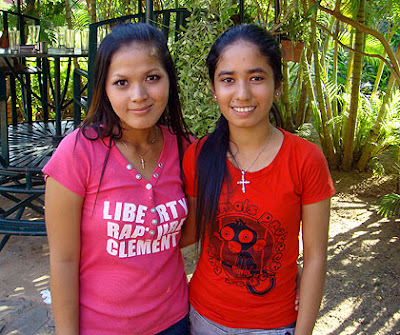
Two of the older generation, at sixteen years old, are Srey Nin (left) and Srey Noch

The four 'ice maidens': LtoR: Dany, Srey Pich, Sampoh, Sophia
 To Touch the Soul is a documentary that follows the experiences of educator Carlos Silveira and several California State University students who traveled to Cambodia in 2005 to create art projects with children living with HIV/AIDS. It highlights the emotional ties that Silveira and the students make with the children as they discover a wealth of talented and loving kids. It also shares a message of hope for the future that Cambodian students will replicate what the American students have done and take a lead in educating and caring for their own kind. The 70-minute documentary focuses on two NGOs called Little Sprouts and Little Folks, where the children are either HIV-positive or orphaned by AIDS. It's full to brimming with the unconditional love and affection that Cambodian kids are renowned for, the courage of a child like Seima who has plans to run his own school but may never live long enough to achieve his goal, and the dedication of people like John Tucker, who has worked tirelessly for the last seven years in making a difference to the lives of children living with and affected by HIV. The Meta House showing tonight was well-attended and included Silveira, Tucker and director Ryan Goble, who were on-hand to answer questions after the screening. The documentary will get its first international film festival showing in Australia very soon and fingers-crossed, someone like PBS will pick it up and show it across the United States. Despite their situation, the film illustrates that children living with HIV can flourish given the opportunity and that message of hope is a beacon in the lives of those suffering with the disease.
To Touch the Soul is a documentary that follows the experiences of educator Carlos Silveira and several California State University students who traveled to Cambodia in 2005 to create art projects with children living with HIV/AIDS. It highlights the emotional ties that Silveira and the students make with the children as they discover a wealth of talented and loving kids. It also shares a message of hope for the future that Cambodian students will replicate what the American students have done and take a lead in educating and caring for their own kind. The 70-minute documentary focuses on two NGOs called Little Sprouts and Little Folks, where the children are either HIV-positive or orphaned by AIDS. It's full to brimming with the unconditional love and affection that Cambodian kids are renowned for, the courage of a child like Seima who has plans to run his own school but may never live long enough to achieve his goal, and the dedication of people like John Tucker, who has worked tirelessly for the last seven years in making a difference to the lives of children living with and affected by HIV. The Meta House showing tonight was well-attended and included Silveira, Tucker and director Ryan Goble, who were on-hand to answer questions after the screening. The documentary will get its first international film festival showing in Australia very soon and fingers-crossed, someone like PBS will pick it up and show it across the United States. Despite their situation, the film illustrates that children living with HIV can flourish given the opportunity and that message of hope is a beacon in the lives of those suffering with the disease.
To Touch The Soul director Ryan Goble (left) and your blogging correspondent
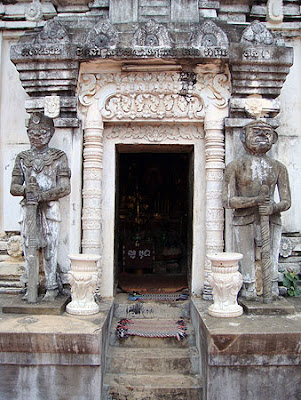
The doorway to the tower, guarded by fierce figures

Is this lintel, in a pre-Angkorean style, an original or a copy?

Part of a large collection of buddhas inside the tower One of two upright lions at the front entrance of the tower of Wat Prasat
One of two upright lions at the front entrance of the tower of Wat Prasat
 If I can recover from a debilitating bout of diarrhea and vomiting - you really didn't want to hear that did you - I will attend the Meta House film night this evening (starting at 7pm), which is showing a brand new feature-length documentary called To Touch the Soul. The film's director Ryan Goble will be present at the screening, having made the trip back to Cambodia armed with sixteen computers for children featured in the documentary.
If I can recover from a debilitating bout of diarrhea and vomiting - you really didn't want to hear that did you - I will attend the Meta House film night this evening (starting at 7pm), which is showing a brand new feature-length documentary called To Touch the Soul. The film's director Ryan Goble will be present at the screening, having made the trip back to Cambodia armed with sixteen computers for children featured in the documentary. If I can recover from a debilitating bout of diarrhea and vomiting - you really didn't want to hear that did you - I will attend the Meta House film night this evening (starting at 7pm), which is showing a brand new feature-length documentary called To Touch the Soul. The film's director Ryan Goble will be present at the screening, having made the trip back to Cambodia armed with sixteen computers for children featured in the documentary.
If I can recover from a debilitating bout of diarrhea and vomiting - you really didn't want to hear that did you - I will attend the Meta House film night this evening (starting at 7pm), which is showing a brand new feature-length documentary called To Touch the Soul. The film's director Ryan Goble will be present at the screening, having made the trip back to Cambodia armed with sixteen computers for children featured in the documentary. The skyline of Phnom Penh is changing fast these days, and in the next few years it will change beyond all recognition. The 12-storey building above is a mere minnow in the face of three projects that are either in the throes of building already or under development. The Gold Tower 42 is due for completion in 2011 at the corner of Sihanouk and Monivong Boulevards, will cost $2.4 billion and as the name suggests, will be 42 storeys high. It's gonna be a whopper. However, a Korean developer has announced plans for a 52-storey residential and office monstrosity near the Russian Embassy, costing $1.1 billion and completion set for 2012. The other biggy in the works is a 30-storey, $20 million project near the Railway Station, which will complete next year. Everywhere I look in my own area of the city, Boeung Keng Kang 1, my view is obstructed by green netting surrounding constructions like the one above. They are literally everywhere, most of them are new residential apartment blocks available only to the wealthy - so that's me out of the equation. Someone once told me it's a sign of progress - but as a long-time lover of the 'good old days' in Cambodia, it's extremely painful to my 1 eye!
The skyline of Phnom Penh is changing fast these days, and in the next few years it will change beyond all recognition. The 12-storey building above is a mere minnow in the face of three projects that are either in the throes of building already or under development. The Gold Tower 42 is due for completion in 2011 at the corner of Sihanouk and Monivong Boulevards, will cost $2.4 billion and as the name suggests, will be 42 storeys high. It's gonna be a whopper. However, a Korean developer has announced plans for a 52-storey residential and office monstrosity near the Russian Embassy, costing $1.1 billion and completion set for 2012. The other biggy in the works is a 30-storey, $20 million project near the Railway Station, which will complete next year. Everywhere I look in my own area of the city, Boeung Keng Kang 1, my view is obstructed by green netting surrounding constructions like the one above. They are literally everywhere, most of them are new residential apartment blocks available only to the wealthy - so that's me out of the equation. Someone once told me it's a sign of progress - but as a long-time lover of the 'good old days' in Cambodia, it's extremely painful to my 1 eye!  Opposite the Hanuman offices on Street 310 here in Phnom Penh, is a traditional medicine shop that produces various potions and pills on site. I often see a group of women sorting pills, pellets, tablets, herbs, roots, or just about anything into packets or drying the medicines in the sun on the pavement, as you can see above. These particular pills were a gorgeous violet colour when I spotted them at midday today and on closer inspection, were the size of a pea, rock-hard and artificially coloured. The shop owner, part of the famous Tep Leap traditional medicine chain of shops, told me the pills are used to alleviate problems with male constipation, though I couldn't work out why men and women might have different pills for this ailment. Though I know absolutely nothing about it, this fascinating form of medicine has its roots firmly in Asia and modern drugs have been developed from some of the herbs, trees and scrubs used for centuries by local inhabitants who swear by these remedies.
Opposite the Hanuman offices on Street 310 here in Phnom Penh, is a traditional medicine shop that produces various potions and pills on site. I often see a group of women sorting pills, pellets, tablets, herbs, roots, or just about anything into packets or drying the medicines in the sun on the pavement, as you can see above. These particular pills were a gorgeous violet colour when I spotted them at midday today and on closer inspection, were the size of a pea, rock-hard and artificially coloured. The shop owner, part of the famous Tep Leap traditional medicine chain of shops, told me the pills are used to alleviate problems with male constipation, though I couldn't work out why men and women might have different pills for this ailment. Though I know absolutely nothing about it, this fascinating form of medicine has its roots firmly in Asia and modern drugs have been developed from some of the herbs, trees and scrubs used for centuries by local inhabitants who swear by these remedies.  The pagoda of Wat Prasat, in the Bati district just off National Road 2, has a very interesting building in the corner of the temple grounds, which I'll introduce you to very soon. In the meantime, this Neak Ta, or powerful guardian spirit, was residing in a small stone-built spirit house in the grounds of Wat Prasat. Even though Neak Ta are essentially part of the animist beliefs of Cambodians, they are often found in Buddhist pagodas or located elsewhere in a village where the locals believe their powers and energy force will do most good. The shrines or huts of Neak Ta literally contain anything, natural or man-made. The objects represent the land, water and spirit elements and often house small figures, some gaudily painted or worn through time, like the one above. The offerings to the Neak Ta can also be seen in the photo. In many instances, I have seen sculpted items taken from ancient temples and statues and worshipped as Neak Ta. If you see a shrine on your travels, take a moment to look in and see what treasures you can find - but never disturb the contents or you might face the wrath of the all-powerful Neak Ta.
The pagoda of Wat Prasat, in the Bati district just off National Road 2, has a very interesting building in the corner of the temple grounds, which I'll introduce you to very soon. In the meantime, this Neak Ta, or powerful guardian spirit, was residing in a small stone-built spirit house in the grounds of Wat Prasat. Even though Neak Ta are essentially part of the animist beliefs of Cambodians, they are often found in Buddhist pagodas or located elsewhere in a village where the locals believe their powers and energy force will do most good. The shrines or huts of Neak Ta literally contain anything, natural or man-made. The objects represent the land, water and spirit elements and often house small figures, some gaudily painted or worn through time, like the one above. The offerings to the Neak Ta can also be seen in the photo. In many instances, I have seen sculpted items taken from ancient temples and statues and worshipped as Neak Ta. If you see a shrine on your travels, take a moment to look in and see what treasures you can find - but never disturb the contents or you might face the wrath of the all-powerful Neak Ta.  Wow, I feel tired just reading about the work going on at the Chrauk Tiek Primary School in the shadow of the Cardamom Mountains. That's where Kari Grady Grossman, her family and helpers are at the moment, assisting the local school and community to change the dynamic of environmental destruction and rural school poverty in Cambodia. From little acorns...
Wow, I feel tired just reading about the work going on at the Chrauk Tiek Primary School in the shadow of the Cardamom Mountains. That's where Kari Grady Grossman, her family and helpers are at the moment, assisting the local school and community to change the dynamic of environmental destruction and rural school poverty in Cambodia. From little acorns...
 I was very pleased to meet Asad and Olivia in person for the first time this morning. They visited me at the Hanuman offices as they were passing through Phnom Penh. They've formed an organization called Project Enlighten to help children in Cambodia with educational and vocational skills opportunities that they wouldn't have otherwise had. Both are wildland firefighters in the United States and have been in Cambodia since early December, assessing the needs that their organization can fulful and doing what they can on the ground. They will return to the States later this week. Their dreams and goals for the children of Cambodia are heart-felt and passionate and I wish them every success. You can keep up to date on their travels via their blog.
I was very pleased to meet Asad and Olivia in person for the first time this morning. They visited me at the Hanuman offices as they were passing through Phnom Penh. They've formed an organization called Project Enlighten to help children in Cambodia with educational and vocational skills opportunities that they wouldn't have otherwise had. Both are wildland firefighters in the United States and have been in Cambodia since early December, assessing the needs that their organization can fulful and doing what they can on the ground. They will return to the States later this week. Their dreams and goals for the children of Cambodia are heart-felt and passionate and I wish them every success. You can keep up to date on their travels via their blog.

The bell-shaped stupa with the blue hood marks the center of the ruined prasat

One of the guardian lions bearing fangs and bulbous eyes

This half standing guardian lion is one of four at the site of the ruined prasat

The east gate to Ta Prohm's central sanctuary, showing the dying Buddha lintel

The lintel of three registers on the western doorway at Yeay Peau

The charitable Prince Vessantara and his family are banished from the kingdom

The more minimal Churning scene on the north westen wall of the central sanctuary
 The 12th century prasat of Ta Prohm at Tonle Bati, 30kms south of Phnom Penh has quite a few unusual carvings that you rarely find anywhere else amongst the thousands of Angkorean temples that once flourished throughout the kingdom. Take the devata - heavenly goddess - above, in a niche of the main sanctuary. There's a faint trace of red lipstick on her full smiling lips but its the mirror that she's holding in her right hand, to admire her face which is adorned with a jewel in her forehead that is so unusual. Her head-dress is extravagant and her demeanour is of a refined elegance. Each of the devatas of Ta Prohm is unique.
The 12th century prasat of Ta Prohm at Tonle Bati, 30kms south of Phnom Penh has quite a few unusual carvings that you rarely find anywhere else amongst the thousands of Angkorean temples that once flourished throughout the kingdom. Take the devata - heavenly goddess - above, in a niche of the main sanctuary. There's a faint trace of red lipstick on her full smiling lips but its the mirror that she's holding in her right hand, to admire her face which is adorned with a jewel in her forehead that is so unusual. Her head-dress is extravagant and her demeanour is of a refined elegance. Each of the devatas of Ta Prohm is unique. Following my visit to Meta House last night for the Nhok Sinat classical performance, I popped into the Bai Thong Thai restaurant, close to the Cambodia-Vietnam Friendship Monument on Sothearos Boulevard. Lovely food, nice price and beautiful decor. Its another of the Luu Meng chain of eateries that are proliferating in Phnom Penh.
Speaking to Charley Todd last evening at Meta, he'd been busy this week with the local television company, CTN, filming an hour-long special for a Cambodian audience of the east-meets-west opera, When Elephants Weep, a love story, sung in English and Khmer, unfolding in the horrific aftermath of Pol Pot's genocidal regime and featuring a blend of traditional Cambodian music, Western classical, and rock. Where Elephants Weep is Cambodian Living Arts’ most ambitious new commission to date — the first-known contemporary Cambodian rock opera. Prior commissions have included a hip hop/traditional Khmer fusion CD by the US-based Khmer trio SEASIA and a new shadow puppet production and nationwide tour by the Phnom Penh-based theater company Sovanna Phum, in which traditional shadow puppet theater was used as a forum to educate about HIV/AIDS. Read more here.
My sources tell me that GST Express, one of many local bus companies that have increased services and routes across the country as the roads have improved over the last few years, have now begun operating a route that will take travellers and locals into areas that were only readily accessible by more adventurous souls on motorbikes and by 4WD in the past. I'm trying to get more info on the route, but it looks like a service now operates from Siem Reap to Svay Leu (near the Beng Mealea temple) and onto Sroyang (the nearest village stop-off point for the Koh Ker complex of temples). The bus continues onto the large village of Koulen and then Tbeng Meanchey, the provincial capital of Preah Vihear province. This would allow travellers access to this previously remote province which has a proliferation of ancient temples such as the breathtaking Preah Vihear and the cluster of temples around the village of Choam Khsan. The bus then drops southwards to Kompong Thom and onto Kompong Cham before ending its journey at Phnom Penh. That's the gen I've heard, not yet confirmed as no-one at GST spoke English when I called them a few minutes ago - and my Khmer is practically non-existent! If that route is now operating, its another way for travellers to gain access to some of these locations, cheaply and in some comfort - considerably different to my first experience in that part of the country, way back in November 2001. Read more here.
Update: GST, when quizzed on the bus route, tell me that they do indeed run some new routes into the north of Cambodia but at the moment, they only do the Phnom Penh to Tbeng Meanchey route every day. It leaves the capital around 7am and takes about 6 hours, costing $10. They don't run a bus from Tbeng Meanchey to Siem Reap. So, the route is less extensive than I thought, but its still a great way to get into Preah Vihear province in some comfort. From Tbeng Meanchey the whole province is your oyster!
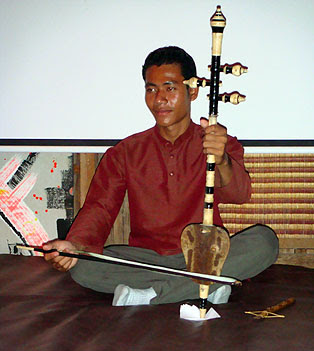 Nhok Sinat performing on the classical musical instrument, the tro khmer
Nhok Sinat performing on the classical musical instrument, the tro khmer 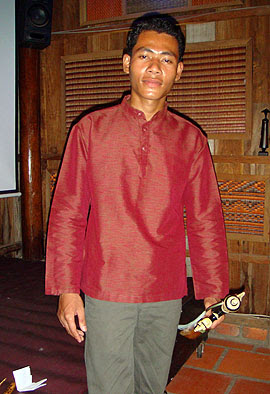 Nhok Sinat, a master musician in the making
Nhok Sinat, a master musician in the making A wooden water bath was used to extract confessions at Tuol Sleng
A wooden water bath was used to extract confessions at Tuol Sleng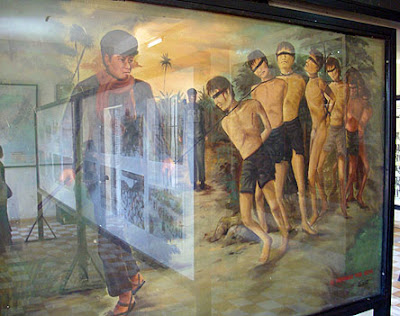 Prisoners are led blindfolded to their execution at Choeung Ek
Prisoners are led blindfolded to their execution at Choeung Ek Vann Nath depicts the execution of prisoners at Choeung Ek, on the city's outskirts
Vann Nath depicts the execution of prisoners at Choeung Ek, on the city's outskirts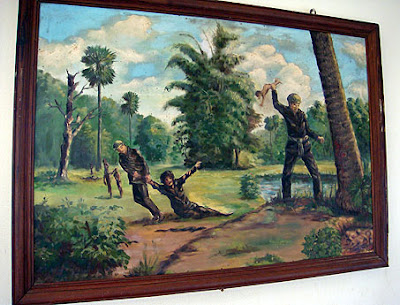 Another scene depicting the cruelty of the Khmer Rouge cadre
Another scene depicting the cruelty of the Khmer Rouge cadre This final photo shows the Khmer Rouge cadre giving no mercy to anyone, children included
This final photo shows the Khmer Rouge cadre giving no mercy to anyone, children included  An impression by Vann Nath of how the gallows in the school grounds were used for torture
An impression by Vann Nath of how the gallows in the school grounds were used for torture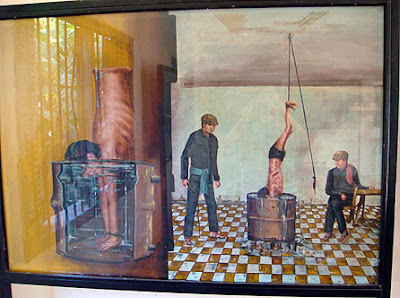 Water torture of varying degrees was a common torture technique
Water torture of varying degrees was a common torture technique Another type of water torture, inflicted on prisoners to obtain confessions
Another type of water torture, inflicted on prisoners to obtain confessions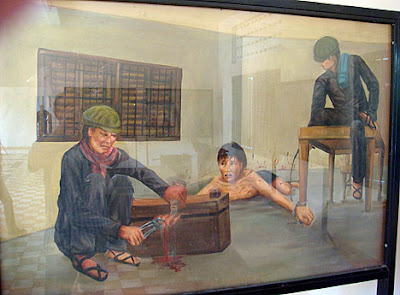 More of the torture techniques employed by the KR interrogators
More of the torture techniques employed by the KR interrogators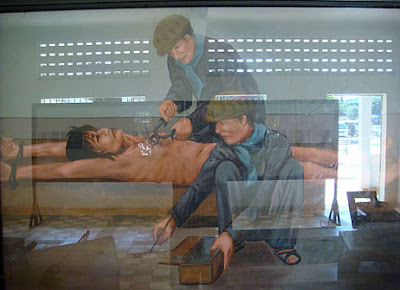
 A self portrait of Vann Nath during his S-21 incarceration
A self portrait of Vann Nath during his S-21 incarceration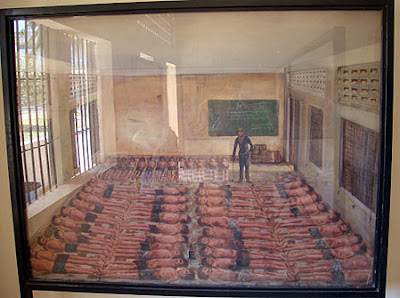 One of the mass detention cells in which more than 50 prisoners were shackled together
One of the mass detention cells in which more than 50 prisoners were shackled together Khmer Rouge guards carrying one of the prisoners after interrogation
Khmer Rouge guards carrying one of the prisoners after interrogation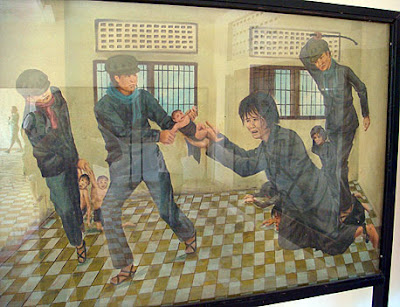 Mothers and children were separated on arrival
Mothers and children were separated on arrival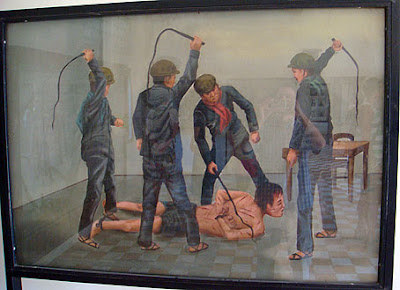
 A memorial to the deceased in the final room of the Tuol Sleng museum
A memorial to the deceased in the final room of the Tuol Sleng museum Over 300 skulls are kept in glass cabinets in the room
Over 300 skulls are kept in glass cabinets in the room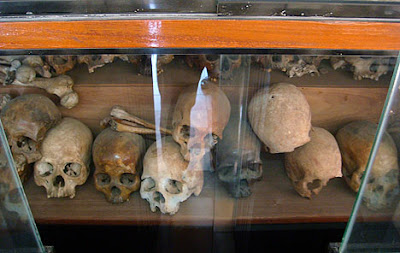 These skulls used to form the wall map of Cambodia composed of skulls and bones
These skulls used to form the wall map of Cambodia composed of skulls and bones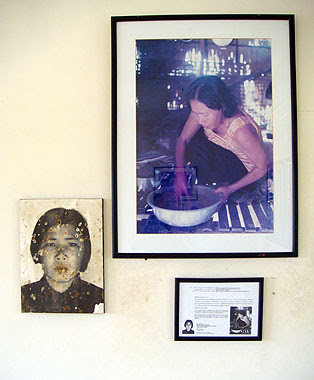 Khmer Rouge cadre Tuy Kin, pictured at home by Heng Sinith
Khmer Rouge cadre Tuy Kin, pictured at home by Heng Sinith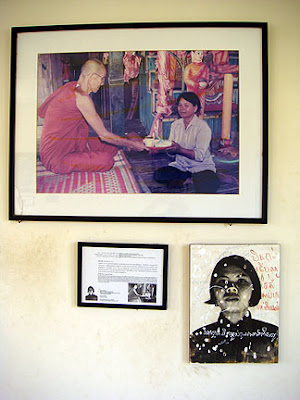 Another former cadre, Soam Nim, a KR group leader during the '70s
Another former cadre, Soam Nim, a KR group leader during the '70s The northern most building at Tuol Sleng, Block D
The northern most building at Tuol Sleng, Block D Implements of death and torture used at Tuol Sleng
Implements of death and torture used at Tuol Sleng Public Enemy & Brother Number One - Pol Pot
Public Enemy & Brother Number One - Pol Pot Some of the famous faces that died under the Pol Pot regime include the singers Sin Sisamouth, Ros Sereysothea and Houy Meas
Some of the famous faces that died under the Pol Pot regime include the singers Sin Sisamouth, Ros Sereysothea and Houy Meas
 Tuol Sleng: A decrepit wooden stupa used to stand in front of Block C, with its barbed-wire frontage
Tuol Sleng: A decrepit wooden stupa used to stand in front of Block C, with its barbed-wire frontage Individual cells made of house bricks or breeze-blocks are on the ground floor
Individual cells made of house bricks or breeze-blocks are on the ground floor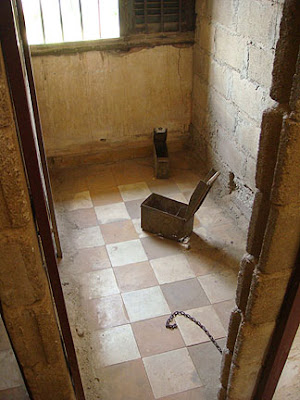 Far fewer of the cells contain leg irons, chains and old USA ammunition boxes these days
Far fewer of the cells contain leg irons, chains and old USA ammunition boxes these days The barbed-wire frontage of Block C to prevent suicide attempts
The barbed-wire frontage of Block C to prevent suicide attempts
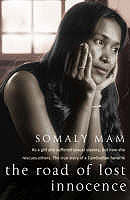 I've been waiting for Somaly Mam's memoir to be published in English for ages and I see its due out, through Virago Press on 17 January in the UK, priced at £12.99. However, its already in the bookshops in Australia and I need to get my copy as soon as possible - as it's required reading. Published in French at least a couple of years ago, The Road of Lost Innocence tells the story of Somaly Mam, who was abandoned as a baby and looked after by her grandmother until she disappeared. She was then taken into the care of a man she called 'grandfather', but was treated no better than an unpaid servant. Raped at twelve, Somaly was forced to marry at fifteen and then sold to a brothel. She endured years of abuse before managing to escape. Her memoir is a moving account of a traumatic childhood and also the inspirational story of a determined and courageous woman devoted to helping other girls caught up in the illegal sex trade in Cambodia. In 1997 Somaly Mam co-founded AFESIP to combat trafficking in women and children for sexual slavery. You can read more about Somaly's crusade here.
I've been waiting for Somaly Mam's memoir to be published in English for ages and I see its due out, through Virago Press on 17 January in the UK, priced at £12.99. However, its already in the bookshops in Australia and I need to get my copy as soon as possible - as it's required reading. Published in French at least a couple of years ago, The Road of Lost Innocence tells the story of Somaly Mam, who was abandoned as a baby and looked after by her grandmother until she disappeared. She was then taken into the care of a man she called 'grandfather', but was treated no better than an unpaid servant. Raped at twelve, Somaly was forced to marry at fifteen and then sold to a brothel. She endured years of abuse before managing to escape. Her memoir is a moving account of a traumatic childhood and also the inspirational story of a determined and courageous woman devoted to helping other girls caught up in the illegal sex trade in Cambodia. In 1997 Somaly Mam co-founded AFESIP to combat trafficking in women and children for sexual slavery. You can read more about Somaly's crusade here.  The stark numbers involved at Choeung Ek include 8,985 victims' remains uncovered
The stark numbers involved at Choeung Ek include 8,985 victims' remains uncovered The Choeung Ek site during exhumation in late 1980
The Choeung Ek site during exhumation in late 1980 Some of the victims blindfolds remained intact
Some of the victims blindfolds remained intact Rows of victims skulls were shown on tv news stations across the globe
Rows of victims skulls were shown on tv news stations across the globe
 Even the youngest were pictured before their deaths. Over 2,000 children are believed to have died at Tuol Sleng
Even the youngest were pictured before their deaths. Over 2,000 children are believed to have died at Tuol Sleng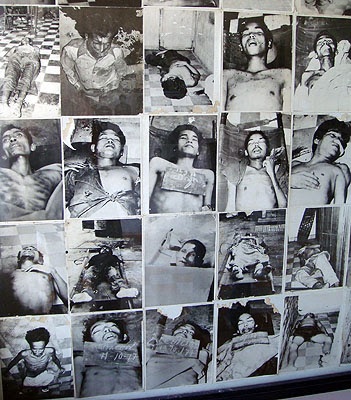 20 prisoners photographed immediately after their death in custody
20 prisoners photographed immediately after their death in custody All of these prisoners arrived at S-21 in 1978. None survived
All of these prisoners arrived at S-21 in 1978. None survived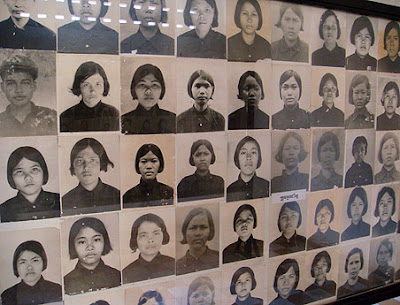 Some of the female staff at S-21
Some of the female staff at S-21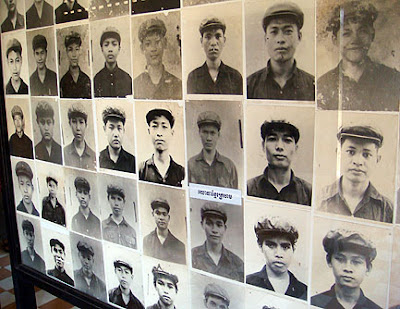 The male cadre at S-21, none of which were exempt from suspicion and custody themselves
The male cadre at S-21, none of which were exempt from suspicion and custody themselves A foreign visitor views a photo of Chan Kim Srung, holding her newborn baby
A foreign visitor views a photo of Chan Kim Srung, holding her newborn baby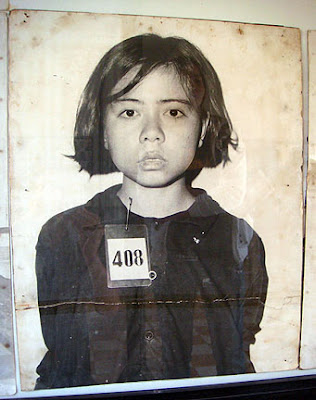 A young female is photographed on her arrival at Tuol Sleng
A young female is photographed on her arrival at Tuol Sleng Two Cambodian students finding out more about their country's recent history
Two Cambodian students finding out more about their country's recent history Another frightened youngster, his neck in chains, is pictured on arrival
Another frightened youngster, his neck in chains, is pictured on arrival
 Bangkok-based art dealer and internationally-recognised expert on Khmer Art, Douglas Latchford, has donated two sets of gold and crystal royal regalia to the National Museum in Phnom Penh. Hats off to Doug (pictured right), a 76 year old British collector whose donation has greatly enhanced the museum's flagging collection of gold items, as the very few pieces of Angkorean gold in existence are in private collections. The king and queen sets are believed to date from the 12th century. Latchford's latest book, co-authored with Emma Bunker, is called Khmer Gold: Gifts for the Gods, and follows on from the duo's joint effort in 2004, Adoration and Glory: The Golden Age of Khmer Art. Quirkily, when the book was released in Bangkok, Latchford, who is big into body-building competitions, hosted the event with the help of Thai tv and his body-building chums who modelled some of the pieces from his collection.
Bangkok-based art dealer and internationally-recognised expert on Khmer Art, Douglas Latchford, has donated two sets of gold and crystal royal regalia to the National Museum in Phnom Penh. Hats off to Doug (pictured right), a 76 year old British collector whose donation has greatly enhanced the museum's flagging collection of gold items, as the very few pieces of Angkorean gold in existence are in private collections. The king and queen sets are believed to date from the 12th century. Latchford's latest book, co-authored with Emma Bunker, is called Khmer Gold: Gifts for the Gods, and follows on from the duo's joint effort in 2004, Adoration and Glory: The Golden Age of Khmer Art. Quirkily, when the book was released in Bangkok, Latchford, who is big into body-building competitions, hosted the event with the help of Thai tv and his body-building chums who modelled some of the pieces from his collection.  The out-of-bounds first floor of Block B contains the S-21 archive
The out-of-bounds first floor of Block B contains the S-21 archive The top floor of Block B houses an exhibition of photos and stories from the book, Stilled Lives
The top floor of Block B houses an exhibition of photos and stories from the book, Stilled Lives One of the Stilled Lives stories involves sisters Mong Sam Oeun (left) and Kep Sothea (right)
One of the Stilled Lives stories involves sisters Mong Sam Oeun (left) and Kep Sothea (right) Four effigies of Pol Pot behind bars - something that never happened whilst he was alive
Four effigies of Pol Pot behind bars - something that never happened whilst he was alive
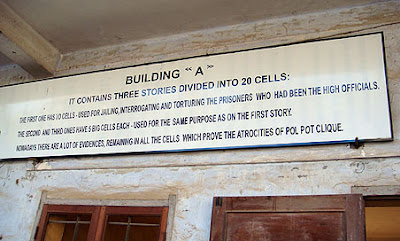 A new sign hanging on Block A explains the different types of cells on each floor
A new sign hanging on Block A explains the different types of cells on each floor One of the larger cells on the second floor of Block A
One of the larger cells on the second floor of Block A One of the original photos showing the recently murdered prisoner as he was discovered
One of the original photos showing the recently murdered prisoner as he was discovered One of the ten smaller cells on the ground floor of Block A, reserved for important prisoners
One of the ten smaller cells on the ground floor of Block A, reserved for important prisoners
An original iron bedstead with latrine box, leg irons and plate
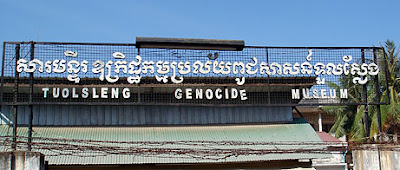 With my regular motodop feeling unwell, my plan to visit Phnom Chisor bit the dust so I seized the opportunity this morning to revisit Tuol Sleng Genocide Museum, which I've visited many times in the past. It's always a place that has held a morbid interest for me after I heard of its existence in John Pilger's Year Zero documentary in 1979. My first visit was in 1994 and at that time it was still very raw in its impact and the site was poorly-maintained, compared to the more sanitized conditions you see today. Nevertheless, the overall effect remains and for some its too much - I saw a few western visitors weeping silent tears in a couple of the rooms - though the number of tourists at the site today implies it remains one of the 'must see' stops on the tourist trail in the capital.
With my regular motodop feeling unwell, my plan to visit Phnom Chisor bit the dust so I seized the opportunity this morning to revisit Tuol Sleng Genocide Museum, which I've visited many times in the past. It's always a place that has held a morbid interest for me after I heard of its existence in John Pilger's Year Zero documentary in 1979. My first visit was in 1994 and at that time it was still very raw in its impact and the site was poorly-maintained, compared to the more sanitized conditions you see today. Nevertheless, the overall effect remains and for some its too much - I saw a few western visitors weeping silent tears in a couple of the rooms - though the number of tourists at the site today implies it remains one of the 'must see' stops on the tourist trail in the capital.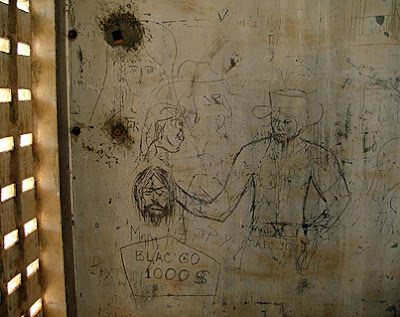
This looks like the head of Jesus being carried by a Wild West syle gunslinger!

The 1960s bouffant style hair-do's are reflected in the two graffiti drawings

Another '60s bouffant as worn by singer Ros Sereysothea, who disappeared under the Khmer Rouge, presumed dead
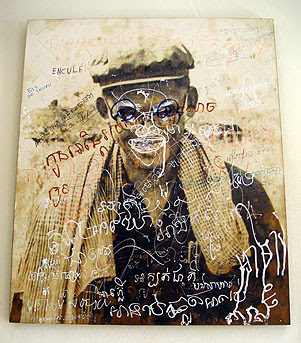
A defaced photo of Son Sen, the Khmer Rouge Defence Minister with responsibility for the activities that took place at Tuol Sleng
 The Three Srey's look decidely nervous next to the 'barang'
The Three Srey's look decidely nervous next to the 'barang'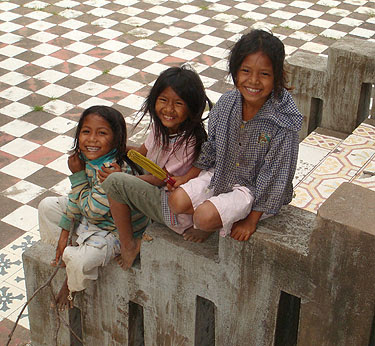 Typical smiles from the Three Srey's on the steps of Yeay Peau
Typical smiles from the Three Srey's on the steps of Yeay Peau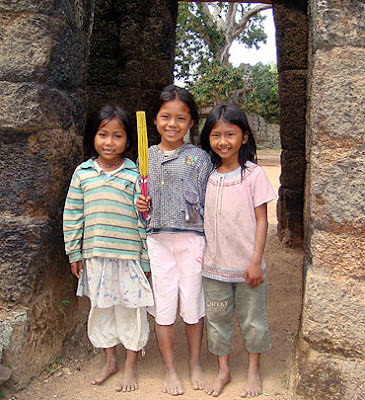
 Three worshippers in stone at the entrance to Ta Prohm temple at Tonle Bati
Three worshippers in stone at the entrance to Ta Prohm temple at Tonle Bati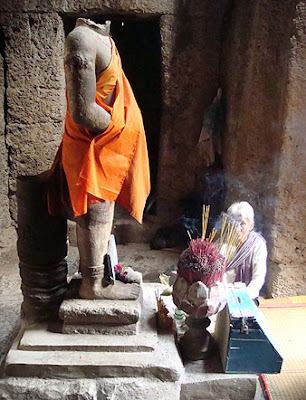 A headless statue in one of the chambers deep within Ta Prohm temple
A headless statue in one of the chambers deep within Ta Prohm temple
 The genocide memorial stupa at Wat Troap Kor in Bati district
The genocide memorial stupa at Wat Troap Kor in Bati district The neatly displayed remains of genocide victims at Wat Troap Kor
The neatly displayed remains of genocide victims at Wat Troap Kor
Human bones and incense sticks
The third genocide memorial I visited in the Bati district of Takeo province on New Year's Day was at Wat Troap Kor. Half an hour further south from Wat Ka Koh, this pagoda was about 10 kilometres west of the market at Samraong Yaong village on Route 2. I passed through sleepy villages and two other pagodas before reaching my destination. The pagoda itself was closed, the monks asleep and there was no-one around who knew the whereabouts of the memorial. That meant a search of the grounds until I located the memorial stupa near the front gate. Built in May 2006 thanks to donations that totalled $2,750 according to the writing on the stupa wall, the door was unlocked and the bones were neatly stacked, with approximately thirty skulls on display. Wat Troap Kor was the site of more than 70 mass graves that are believed to have contained upwards of 40,000 victims of the Khmer Rouge genocide, according to the DC-Cam files. In total, within Takeo province there are nine such memorials honouring the deceased, and eighty across the country as a whole.
 The newly-painted pagoda at Wat Kork Ksang
The newly-painted pagoda at Wat Kork Ksang A story from the life of Buddha on the walls of the first floor at Wat Kork Ksang
A story from the life of Buddha on the walls of the first floor at Wat Kork Ksang 4 of the pagoda's seima stones with intricate patterns
4 of the pagoda's seima stones with intricate patterns The demon Rahu is depicted eating the Moon on the ceiling of Wat Anlong Romead
The demon Rahu is depicted eating the Moon on the ceiling of Wat Anlong Romead The old vihara at Wat Anlong Romead
The old vihara at Wat Anlong Romead This young girl had been collecting grass in the fields
This young girl had been collecting grass in the fields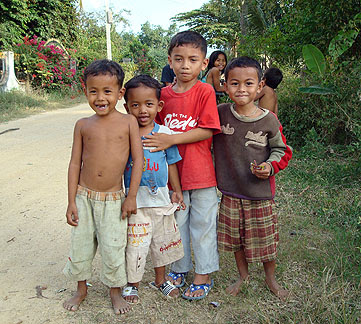
These cheerful youngsters were soon kicking lumps out of me on the football pitch
 A couple of weeks ago I went for a Saturday afternoon moto-ride along Route 3 in a westerly direction from Phnom Penh with no agenda, just to stop where the whim took me. The above photo was snapped as I paused to inspect a new canal and irrigation scheme built with funds provided by the Japanese development agency. The gaggle of children at my side thought they would investigate who I was and the eldest two girls asked me what was I doing, where was I from, what was my name and so on. I was impressed by their forwardness and lack of fear, which isn't always the case on my travels into the countryside. In fact, quite the opposite has been the response on many occasions, with small children running away as fast as their little legs will carry them, screaming at my arrival. I can understand that...
A couple of weeks ago I went for a Saturday afternoon moto-ride along Route 3 in a westerly direction from Phnom Penh with no agenda, just to stop where the whim took me. The above photo was snapped as I paused to inspect a new canal and irrigation scheme built with funds provided by the Japanese development agency. The gaggle of children at my side thought they would investigate who I was and the eldest two girls asked me what was I doing, where was I from, what was my name and so on. I was impressed by their forwardness and lack of fear, which isn't always the case on my travels into the countryside. In fact, quite the opposite has been the response on many occasions, with small children running away as fast as their little legs will carry them, screaming at my arrival. I can understand that... 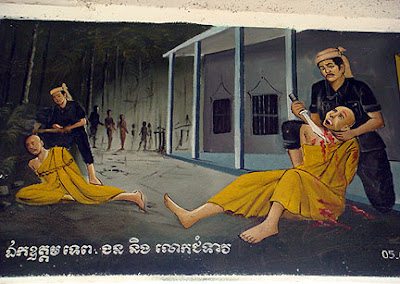 No-one was spared, monks in particular were targetted by the Khmer Rouge's brutal regime
No-one was spared, monks in particular were targetted by the Khmer Rouge's brutal regime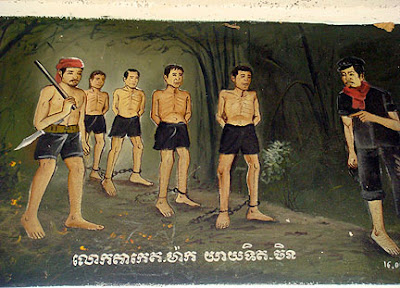 These prisoners are being led away into the forest to be killed
These prisoners are being led away into the forest to be killed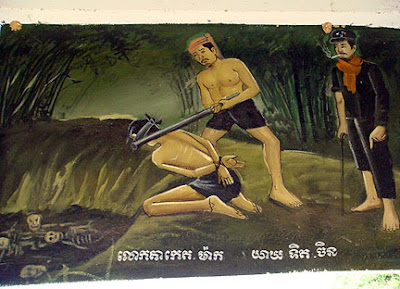 To save ammunition, hoes were used to kill victims at the side of mass grave pits
To save ammunition, hoes were used to kill victims at the side of mass grave pits Women and children were slaughtered by the ruthless Khmer Rouge
Women and children were slaughtered by the ruthless Khmer Rouge 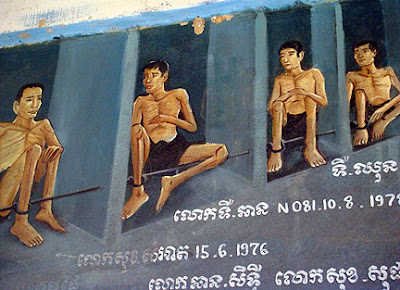 Four of the victims of the Khmer Rouge who've been identified by family members and their likenesses painted in their honour
Four of the victims of the Khmer Rouge who've been identified by family members and their likenesses painted in their honour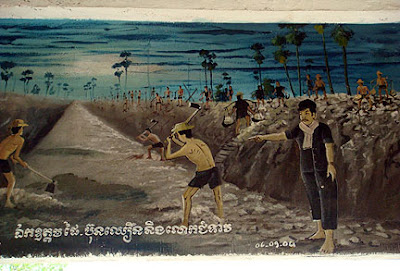 A painting depicting the building of canals and dykes under the orders of the Khmer Rouge
A painting depicting the building of canals and dykes under the orders of the Khmer Rouge Torture including the ripping out of tongues, recalls the work of Vann Nath, which can be seen at the Tuol Sleng Museum
Torture including the ripping out of tongues, recalls the work of Vann Nath, which can be seen at the Tuol Sleng Museum Victims were tortured in water containers by the black-shirted Khmer Rouge
Victims were tortured in water containers by the black-shirted Khmer Rouge The white-washed stupa at Sala Trapeang Sva
The white-washed stupa at Sala Trapeang Sva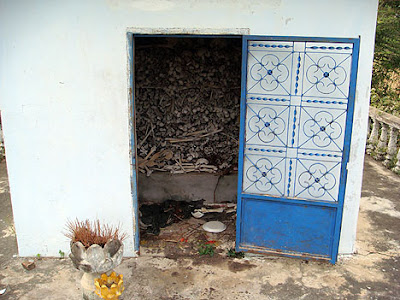 The stupa at Sala Trapeang Sva is full of the remains of victims of the Pol Pot regime
The stupa at Sala Trapeang Sva is full of the remains of victims of the Pol Pot regime  The latest and most comprehensive road atlas for Cambodia has just arrived at Monument Books on Norodom Boulevard, Phnom Penh and is well worth getting a copy. I got mine today, priced $15. The Total Road Atlas is in English and French and contains more complete maps and considerable detail on hundreds of tourist sites, both natural and archaeological. It's aimed at the serious and adventurous traveller who wants to delve deeper into Cambodia, outside of the three main areas of Phnom Penh, Angkor and Sihanoukville. It's a bit bulky at 145 pages and if I was being ultra critical, the province maps, with the addition of more villages and the smaller historic sites, and the town maps, can still be improved with greater detail, but the atlas is the best so far that's available on and in Cambodia. Link: monument books.
The latest and most comprehensive road atlas for Cambodia has just arrived at Monument Books on Norodom Boulevard, Phnom Penh and is well worth getting a copy. I got mine today, priced $15. The Total Road Atlas is in English and French and contains more complete maps and considerable detail on hundreds of tourist sites, both natural and archaeological. It's aimed at the serious and adventurous traveller who wants to delve deeper into Cambodia, outside of the three main areas of Phnom Penh, Angkor and Sihanoukville. It's a bit bulky at 145 pages and if I was being ultra critical, the province maps, with the addition of more villages and the smaller historic sites, and the town maps, can still be improved with greater detail, but the atlas is the best so far that's available on and in Cambodia. Link: monument books. 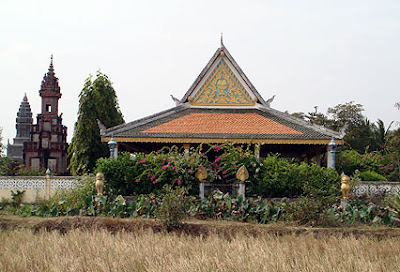 The genocide memorial at Wat Ka Koh, seen from the rice fields in front of the pagoda
The genocide memorial at Wat Ka Koh, seen from the rice fields in front of the pagoda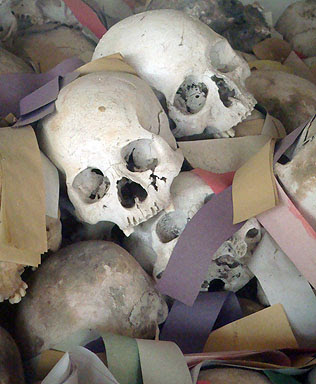 The memorial at Wat Ka Koh contains the remains of 3,000 victims of the Khmer Rouge
The memorial at Wat Ka Koh contains the remains of 3,000 victims of the Khmer Rouge 
The memorial stupa was constructed and designed by the daughter of one of the victims

3,000 of the best-preserved skulls were selected to be housed in the memorial stupa
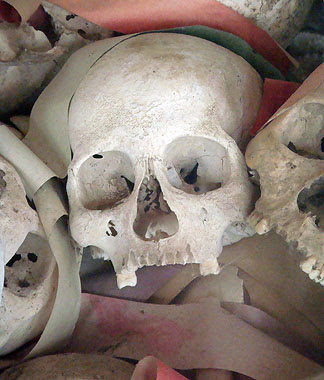
One of the 1.7 million victms of the Khmer Rouge genocide, honoured at Wat Ka Koh